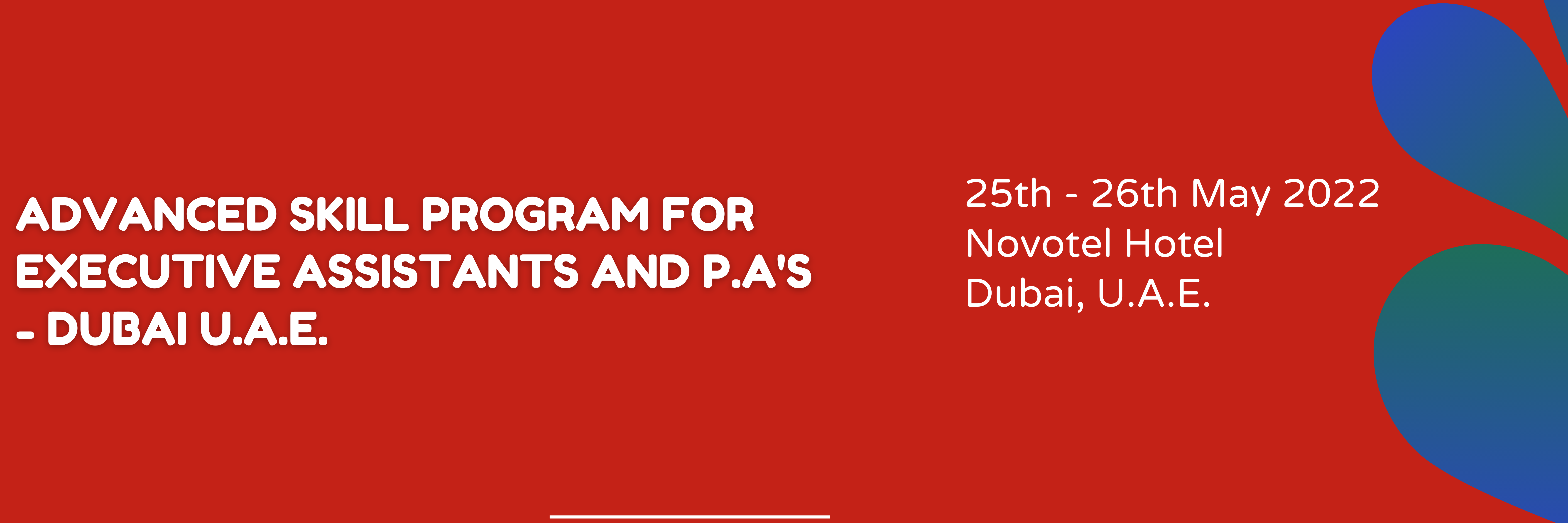Advanced Skill Program for Executive Assistants & P.A’s
25th-26th May, 2024
Novotel Hotel, Dubai U.A.E
Course overview
This 2-day training is an advanced programme that develops the managerial strengths and abilities of 21st century Executive Assistants, Personal Assistants & Secretaries. This groundbreaking training raises the skills and professionalism of this vital workforce sector.
This training has been designed to meet the demand for a comprehensive programme that increases the confidence and abilities of Assistants at work and develops them both professionally and personally.
Course Objectives
Elevate your PA’s and secretaries to higher levels of productivity through these benefits:
• Equip – with the skills, techniques, and tools to become fully multifunctional
• Prepare – for the ever-increasing demands of the 21st century PA through improved time management, enhanced communications skills, and more effective control of meetings and events
• Build – confidence, powers of influence, and self-esteem from a heightened understanding of self-worth, emotional intelligence, assertiveness and management of relationships – especially the
Boss-PA relationship
• Achieve – job satisfaction and career expectations by continuous professional development, balancing work with life and transforming stress
About Course Facilitator:
Our Course Facilitators holds a BSc Honours degree in Speech and Language Pathology from the University of Cape Town, Medical School where she majored in Psychology and Communication Sciences and Disorders.
Moving from medical to the corporate communication application of presentation skills, Michelle began training accent neutralisation, voice, speech in South Africa.
Clients’ Testimonial:
‘I was very impressed with the quality of the course and the facilitator. It is one of the best training programmes I’ve ever attended’ – Manager – Corporate planning and development, Qatar First Investment Bank
‘I thoroughly enjoyed this course! Michelle has a fantastic natural facilitation style that is inviting, approachable, and allows delegates to explore concepts in order to reach solutions that work for them. – Admin Assistant, The Executive Office of HH Sheikha Jawaher Al Qasimi
‘It was an excellent experience’- Personal Assistant to Senior Director, GEMS Education
| Day – 1 |
|---|
| Session One: Leadership |
| • enhancing your management skills set • fine-tuning responsibilities • exploring and identifying leadership styles |
| Session Two: Upwards Management of Your Executive |
| • value tests • time management • the grid of urgency – dealing with time bandits • goal setting • boss v. PA priorities • delegation – managing the relationship with your boss • running the office |
| Session Three: Communications Skills Toolkit |
| • unpacking and practicing proven negotiations skills • developing the art of influence • Build – confidence, powers of influence and selfesteem from a heightened understanding of self-worth, emotional intelligence, assertiveness and management of relationships – especially the Boss-PA relationship |
| Session Four: Building Your Strength in Relationship Management |
| • understanding the enablers of motivation • internal and external drivers • practical motivational forces that you can influence • empowerment – vision – ownership – identifying talent • vision – ownership – identifying talent |
| Day – 2 |
|---|
| Session One: Building your professional identity and image |
| • your telephone image – telephone relationships • combating the five brigades of the telephone army – mastering the equipment • do’s and don’ts of answering the telephone • listening skills – creating one’s identity over the telephone • covering for the boss – assertiveness • more image enhancements |
| Session Two: Meetings, agendas and minutes |
| meetings diagnostics – team-building • meetings alternatives – cost v. effectiveness • meeting types – minute-taking styles • brainstorming – preparations & equipment • partnering with the meeting chairperson – the role of the secretary • participation – note-taking • minute-publishing styles –distribution of agenda and minutes |
| Session Four: Managing your continuous professional development |
| • continuous learning – learning characteristics • Career Growth • sustained self-motivation |
| Session Five: Stress Transformation |
| • analyzing stressors – identifying effects of stress • learning to transform stress |

